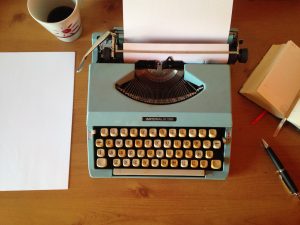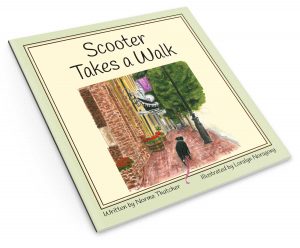
Photo courtesy of Pixabay
Actor Tom Hanks has an unusual interest: typewriters. NPR actually refers to his interest as a “well-documented obsession.” Hanks wrote the forward to a book titled (appropriately enough) Typewriters: Iconic Machines from the Golden Age of Mechanical Writing by Anthony Casillo.
Hanks’ own book Uncommon Type is a series of short stories that have a common element: at some point, a typewriter plays a minor part. I’m about halfway through the book and so far all the typewriters have been manual ones.
Depending on your age, maybe you’ve never seen an actual manual typewriter as pictured above. You cannot compare typing on today’s keyboards to typing on a manual typewriter.
You had to press the keys sharply; otherwise the lever holding the metal letter wouldn’t reach the paper to imprint itself. Then you needed a good swing from your left arm to slap the carriage return lever when the bell sounded. The “ding” indicated you were at the end of the right-hand margin. If you want to know what typing on a manual typewriter sounds like, there’s a link at the bottom.
There was no auto-correct; errors needed to be erased or lifted off the paper by using correction tape.
In high school, both my sisters took the commercial course and that included three years of typing classes. The students were tested by use of a proficiency test. The testing allowed no correction of errors; for every error, a sum of five words per minutes was deducted from your score.
In the early 60s ONE electric typewriter was in that high school business classroom. Students were required to take turns using it one week of each grading period in order have at least some experience on the “new- fangled thing.”
Our parents bought my two sisters a Royal manual typewriter for Christmas 1960. It was baby blue and was contained within a large carrying case. On each side of the typewriter were mechanisms to lock it into place within the case.
So between the three years of business class and at-home practice on the manual typewriter, my sisters headed to DC to find work as secretaries. Joining a secretarial pool in the federal workplace in DC, my sister Beverly discovered that manual typewriters were a thing of the past. “It’s electric, baby.”
In 1978 there was another big shift in the typewriter saga from electric to electronic. As with all electronic gadgetry, the price for the latest thing is hefty at first. Amazingly, in 1983 the list price of an electronic typewriter was around $795 according to a New York Times archive article from 1984. In 2018 dollars that would be around $2000.
How did businesses afford to keep up with the times?
When I got to high school half a dozen years after my sisters, my mother insisted that I include at least one year of typing in my class selection. I remember my mom saying that if I could type, I could always get a secretarial job.
She was right; I did initially follow in my sisters’ paths, although I didn’t end up in the metropolitan DC area until years later. And I’m still here!
I have never regretted taking that typing class. Thanks, Mom.
~~~~~~~~~~~
Links for today’s post:




Dear Norma, I always enjoy your email messages.
Today was a special treat. I loved reading about Tom Hanks & remembrances of typewriters.
I remembered fondly about the advances in typewriters. Your descriptions were perfect. By the the way- I still have my 1960 Smith Corona that I took off to college! Thanks, Ruth (friend of Linda R. S.)
I too have to thank my “Mom” as typing was something she required me to take along with shorthand. I might never have made it through college without them! Loved your story!
We may have thought at the time that our moms didn’t know what they were talking about, but guess what? Mother knows best!
Hi Ruth. I’m glad you enjoyed what I “typed.”
I was the same as your sister. I got to use an electric one in class on occasion but I didn’t fare too well. It seemed that I rested my little finger on the end keys and had all kinds of errors. Did finally master the art and was offered a job in DC but declined and found a job in Johnstown. Have always loved typing. Good story. Keep up the good work.
Typewriters seemed to have brought forth memories from many!
Like you, Norma, as you are aware, I took the academic classes but included typing as an elective class. I, too, ended up in DC as an employee of the CIA for a full three months, only to come home to be closer to my husband to be (48 years in May!). But I did continue to use my typing skills in my work life and beyond, with the best use of that skill occurring during my education and then profession as a medical transcriptionist for at least 30 years. AND I too had a blue manual typewriter as a present while in high school at least similar to if not the same as the one pictured above before I purchased a black electric model after I was married and, finally, went to our first computer in the early 1990s. Oh, what progress I’ve seen over the years since that early high school typing class!!!
When I see people (mostly men for some reason) using the old hunt and peck system, I am so grateful for my flying fingers!
One of the funniest things to ever happen to me involved a typewriter. I, too, took typing as an elective in high school and I was darn good at it. I consider it one of my best skills to this day. In fact, as I think about it, typing may be my only skill. I was thrilled to be chosen to represent Laurel Valley at an FBLA typing contest. I loved everything about typing class, even our stern, no-nonsense teacher, Mrs. Mabon, and I was determined to make her proud. Our bus was late arriving at the competition and I slid into my seat just about the time the moderator said, “Ready, set, go!” When I got to the end of the first line I reached for the return arm swiping and swating away frantically without looking up (as any good typist would do). I was horrified to discover in time, that there was no return arm. Although I had heard of them, it was the first time I had ever laid eyes on an electric typewriter. I don’t remember now what the mix up was, or why I was thrown under the bus, but I did not make Mrs. Mabon or anyone else proud that day. Luckily, I made a few people laugh and that was something that was equally important to me in those days.
Yes, that was a sad day for our high school. We were behind the times! Judy and I failed the spelling test that day, but we’re blaming the proctor or representative or whatever her title was because she couldn’t pronounce some of the words! And yes, fortunately, we can look back at that day and laugh!
That typing class served me well (bragging rights: fastest Speed/Accuracy Award in Senior year), so did the shorthand class (“fastest Speed/Accuracy award in Senior year). I still (obviously) use my typing, and I still use my shorthand more often than you might expect. When I was first learning shorthand I “practiced” by listening to the radio and using my shorthand to write down the lyrics.
I recall asking Mom, maybe I was about 12, about the classes she took in high school. Shorthand was one of them, and I had no idea what that was. She explained it, wrote some shorthand words for me, and I still remember one of the words: “mother”. A few years later when in high school, I took my first shorthand class, and I realized that she had written it “upside down.” What she remembered as being the word mother was actually the word some. It’s interesting the unusual, somewhat insignificant memories we all carry around!
I’ve read most, if not all, of your blogs, Norma, and if you haven’t touched on visual vs auditory learning, that might be an interesting topic. I’m a visual learner, and need to write it down, so I can “see” it. Classes delivered by lecture only can be a challenge for visual learners. Thank goodness for my shorthand!!!
Me too! I sit in the front row so I can see the speaker and take notes so I can look at them later.